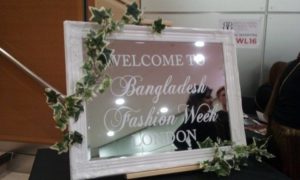I felt a rush of excitement as I entered Canary Wharf’s East Winter Garden for London’s first Bangladesh Fashion Week.
Since the 1970s, Bangladeshis and East London have gone hand in hand. The fashion show reminded me of the resilient attitude of the first Bangladeshis to settle in East London, who overcame a whirlwind of difficulties.

The show was a fusion of East and West. And not just in the clothing lines, but also in the atmosphere. The models on the runway, young British Bengali women, embodied the spirit of multicultural identity. Strong, independent and hard-working British women on the runway, proudly showcasing their ethnic heritage in the context of hipster London.
Walking into the building, I was astounded by the effort that both Bengali and non-Bengali audience members had gone to in order to dress for the occasion! Appropriately enough, to my left there was a miniature red carpet complete with television cameras abuzz with interviews.
Bursting onto the catwalk, British-Bengali journalist Momtaz Begum-Hossain (her hair a bright red bob with a trendy fringe) and social media personality Islah “Mistah Islah” Abdur-Rahman kick-started the proceedings. Islah is widely known for The Corner Shop Show on YouTube, which he launched in March 2014.
Designer Bibi Russell flew to London from Bangladesh, especially to showcase her latest, innovative collection, which ranged from a rainbow East-meets-West fusion, to folklore-inspired pieces. Since graduating from the London College of Fashion in 1975, Russell has become known for her work with top flight designers including Giorgio Armani, YSL and Karl Lagerfeld.
Ranging from modern, intricate wedding gowns to flowing cotton ensembles splayed with Bengali phrases, the daring cuts and the sheer confidence of British Bengali fashion, left me agape; especially Londoner Rukia Ullah’s designs, combining traditional men’s turbans and sarongs with women’s kameezes. In one outfit Ullah matched a deep khaki turban and a brown, silk dress as the top layer, together with a floor-length men’s sarong tied around the model’s waist.
Traditionally, Bengali women are expected to remain calm and composed. However, as soon as topless male models appeared on stage to showcase the men’s clothing range, suddenly chairs scraped back, phones were whipped out and the camera shutters started clicking. So much for remaining ladylike at all times!
BFWL 2016 showed that the Bangladeshi community has reached new heights, giving a new meaning to the term ‘British Bengali’.



